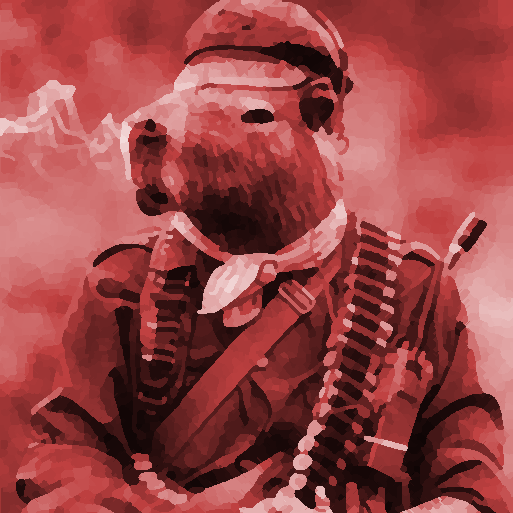Welcome again to everybody! Make yourself at home. Stalin really do be the one. In the time-honoured tradition of our group, here is our weekly discussion thread!
Matrix homeserver at genzedong.org. See this thread for information about our Matrix space. Discord here.
Short reading list for new MLs here. To find theory, try z-lib, libgen, or Sci-Hub (for scientific articles). If an article is unavailable, try the Wayback Machine.


So I watched this DW documentary on Nusantara, and what I found odd was their statistic that 20% of Indonesia’s population are indigenous at 5:50.
In actuality, close to 98% of Indonesia’s population is indigenous if we take conventional meanings of the term.
Don’t get me wrong, indigenous and similar terms, like bumiputera and pribumi have very loaded meanings in maritime Southeast Asia. There are ethnocentric and inclusive interpretations of these terms.
However, the statistic seems just so random. I don’t know of any ethnic classification that consists of 20% of the Indonesian population.
Is this just some settler-colonial insecurities being projected onto a global south country?
Is Indonesia like Latin America in that regard? As in, virtually everyone has indigenous ancestry, but relatively few people have maintained their precolonial customs, language, religion, etc
I wouldn’t say so. Colonisation has a deep and lasting impact on our cultures of course, but to say that none of the precolonial customs were maintained is a bit of a stretch.
It is more accurate to describe Nusantara, or the Malay archipelago, to that of South Asia. Native languages are still spoken. Cultural traditions have largely been maintained. Although, there is now a confluence of Westernised middle classes, reactionary traditionalists and chauvinists, isolated indigenous groups, and accompanying capitalist classes and imperialism attacking collectivist values and structures in our societies.
Just to raise a few points about it, for religion, christianity missionaries did penetrate the southeast Asian archipelago, with the most obvious example being the Phillipines, having a christian majority, but in the case of Malaysia and Indonesia, it had a very limited impact on indigenous religions, most importantly being Islam, Hinduism, and local traditional faiths, however christianity gains prominence the more eastwards you go.
Western Papua and Sarawak (East Malaysia) has christian majorities for example.
Language is another contentious issue, with both left-wing and right-wingers in Malaysia for example, supporting the use of Bahasa Melayu (Malay) as the main language of the government prior to independence. Again this has some exceptions, with for example Sarawak, maintaining English as the de facto language of (state) government even though Malay is the national language.
Indonesia has only bahasa Indonesia as their national language, but other indigenous languages are recognized in the regional level. I can’t say for sure about the specificities of Indonesia’s national language policy, but from what I know, “colonial” languages like Portuguese, English and Dutch have a negligible amount of speakers or relevance there.
Interesting to hear how colonialism impacted these peoples differently. Thanks for sharing! I hope Indonesia continues to resist western imperialism
Latin America is different, in a way, since the racial relations are not the same as in America, though there is its own brand of racism.
What do you mean by “conventional meanings” of indigenous, isn’t there just the one?
A bit of a long response, but I wanted to justify my choice of words with proper care.
What I mean by “conventional meanings” is which ethnic groups in southeast asia are typically considered as indigenous in popular discourse.
For example, Arab peranakans, people who had Arab descendants, are often considered indigenous, while Chinese peranakans are not. Indian peranakans also suffer the same predicament, with some considered indigenous while others are not.
So in my original comment, if we consider chinese Indonesians as indigenous, that would amount to literally 99% of the population, if not just 100% of the population, except for a small segment of eurasians.
Indigenous thus is not about if you were born there, about how long you’ve been there, about the religions you follow or the languages you use but it’s about all of those things all at once, dependent on the sociohistorical conditions of that time.
This was (is) often to the detriment of chinese groups in the region in the 20th and 21st centuries, regardless if they were “totok” (first or second generation immigrants) or peranakan or “straits-born”.
This is further complicated by the political-economy of colonial southeast Asia.
The key point is that there have been “foreign” migration into the Malay archipelago long before European arrivals in the 15th century. Prior to “proper” colonisation in the 16th century.
They were fully incorporated within the respective feudal kingdoms (and mode of production) and some have had mixed blood, and some also completely assimilated to local cultures and customs.
These mixed race individuals formed part (and came from) the mercantalist, trading class that morphed into the “middlemen” class, alongside other mixed race groups (eurasians) as well as other “foreign” ethnic groups during colonisation. They occupied the middle and lower-upper sectors of the racial economic hierarchy in colonial society.
These became the capitalists of post-independence southeast Asia (alongside a fledgling indigenous capitalist class).
Certainly, indigenous southeast Asian peasants were dispossessed of land during colonisation, but they were dispossessed by their own native brethren and europeans through feudal and colonial institutions, not by the vast majority of newly arrived Asian immigrants, which were sometimes either similarly or seperately exploited by european colonizers through indentured and wage labour.
History itself shows this through the proletarian pendatangs and asings (foreigners or aliens) support of the national liberation and decolonization movements in the region.
So, it is unlike the indigenous in the Americas and other settler-colonial nation-states, where a (relatively) clear delineation can be made between settlers and indigenous peoples, through the settler’s expropriation of indigenous land and accompanying genocide. In these societies, indigenous people are defined by their oppression by the settler economy, regardless of cultural assimilation, blood mixture, class or being “non-white”, because that came after the arrival of the settler economy. (If I understand it correctly.)
Silly Westerner.
Edit: I’m being cheeky here, but to answer your question: no, there technically isn’t.
A YouTube link was detected in your comment. Here are links to the same video on Invidious, which is a YouTube frontend that protects your privacy:
Probably.